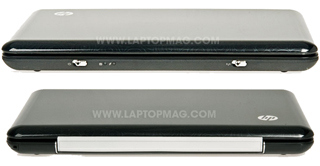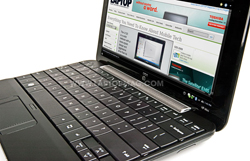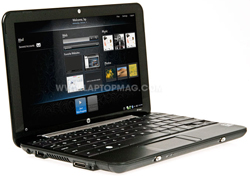Laptop Mag Verdict
This ultralight netbook offers a comfortable keyboard and sleek Linux interface, but its sluggishness and relatively high price hold it back.
Pros
- +
Stylish, compact design
- +
Fun interface
- +
Good selection of bundled apps
- +
Spacious, comfortable keyboard
Cons
- -
Short battery life
- -
Awkwardly placed touch buttons
- -
Sluggish and small hard drive
- -
Only two USB ports
Why you can trust Laptop Mag
Afraid of Linux? Don't be. Although the Mini 1000 Mi Series has the same hardware as theXP versionwe reviewed a few months ago, its OS, which packages a good selection of applications in a clean, innovative interface, enlivens the user experience. While we still have complaints about the Mini 1000's sluggishness, short battery life, and relatively high price ($459), in a market glutted with identically specced machines running XP, it's a refreshing change.
Design
The first thing we noticed about the Mini 1000 Mi is how tiny it is. Particularly compared with compact machines like theMSI Wind U120, another 10-inch netbook, it's 0.3 inches thinner and, at 2.4 pounds, 0.4 ounces lighter. The ASUS 1000HE, by comparison, is 3.2 pounds.
Cosmetically, this system is identical to the Mini 1000 we reviewed with XP. Similar to the full-size HP dv line, it has the company's glossy Swirl Imprint finish, a white swirly pattern over a black background. While not overtly targeted toward women (like theSony VAIO P), the pattern struck us as flowery and a bit feminine. Despite its delicate design, however, the lid felt durable and it resisted smudges.
Keyboard and Touchpad
Compared with the U120, which is 10.2 inches wide, the Mini 1000 Mi makes better use of its keyboard deck: the keyboard, 92 percent the size of a mainstream one, stretches from edge to edge with no extra room on the sides, and the keys look larger, too; they had a pleasantly springy feel and soft finish.
As did the Mini 1000, the Mini 1000 Mi loses design points for the touch buttons awkwardly flanking the touchpad. Even after considerable hands-on time, they remained cumbersome. Although imperfect in its own way, even Sony's decision to forgo the trackpad on the VAIO P for a trackball was more sensible. At least the Mini 1000 Mi's buttons themselves have a soft finish and give good tactile feedback. A handy scrolling strip is on the touchpad, which was responsive, if a bit too sensitive.
Sign up to receive The Snapshot, a free special dispatch from Laptop Mag, in your inbox.
Click to enlarge
Display and Sound
Those interested in the Mi operating system can get the Mini 1000 with either an 8.9-inch or 10.1-inch edge-to-edge display (ours featured the latter). They start at $329 and $379, respectively. We were happy with the 1024 x 600 resolution; those extra few vertical pixels meant we had to do less vertical scrolling than we did with theLenovo IdeaPad S10e, a 10-inch system with a 1024 x 576 display.
The screen has a glossy finish, which makes the Mi OS' fun color palette pop. Although the high glare factor limited our viewing angles from the sides somewhat, we were still able to view the screen when we dipped the lid forward. Moreover, the brightness was easy on our eyes, and helped mitigate the fact that we were staring at a 10.1-inch screen during our testing.
The speaker strip, which is built into the metal hinge, produced surprisingly loud sound when we played music from the main screen.
Ports and Webcam
Click to enlargeAside from the awkwardly placed touch buttons, another trade-off to the Mini 1000's small size is that it has fewer ports than other netbooks: two USB 2.0 ports (not three), as well as a 2-in-1 memory card reader, Ethernet and modem jacks, and headphone and mic ports. It has an expansion port instead of a VGA port, but HP sells an adapter for $29.
The 0.3-megapixel webcam produced dull, ill-lit photos and video. The video, moreover, showed delays even when we recorded a clip off-line; the audio and video often didn't match up. When we pressed the button to start recording, the screen remained black for a few seconds before we could see ourselves. We do like that the Cheese webcam software has a dozen special effects and lists thumbnails of recent photos and videos at the bottom of the console.
Linux Operating System
Click to enlargeThe Mini 1000's Mi (for Mobile Internet; pronounced "me") operating system is built on Ubuntu 8.4 (Hardy Heron). The main screen has a slick, black skin with three vertical panels: Mail (for e-mail), Web (for surfing the net), and Music and Photos. It's nice having these oft-used programs instantly available. We enjoyed the convenience of playing music from the multimedia pane and entering terms into a search bar from the Web panel (the browser will open once you do). We're also digging the Google Chrome-like thumbnails of favorite Web sites. The multimedia section, similarly, shows thumbnails for photo and music albums.
At the bottom of the main screen you'll see small boxes indicating what applications are running (you can see only one app on the screen at a time). The Start New Program box leads to a tabbed menu of all built-in applications. These tabs include Internet, Media, Utilities, Work, Play, and All.
Internet includes the browser, multiclient IM program Pidgin, and Skype 2 for Linux. Media includes the webcam and MediaStyle, which encompasses photo, music, and video programs. Utilities includes a calculator, test editor, software updates, and a file manager. Work includes OpenOffice software. Play includes four games. So, while it's easy enough to find applications that will run on Ubuntu, a popular flavor of Linux, the average consumer might not need any additional programs.
To add new programs. go to Settings > Add/Remove Programs, choose a category of app, and check the box next to the app you want. That's the key: the app list dynamically updates, and you can only add apps that have made it on there. So, even though Mi is built on Ubuntu 8.04, you can't just go to a Web site and copy the deb code to install it. Linux diehards will be disappointed.
Web, E-mail, and IM
Click to enlargeUsers receive mail through Thunderbird, Mozilla's desktop mail client. You can set up whatever e-mail account you like, but Gmail is the only service with a dedicated option; for all others you'll have to enter an incoming and outgoing server.
The browser, Firefox 3.04, has a black skin to match Mi's interface, but will look and feel familiar to most users. All of your favorite keyboard shortcuts (e.g., Ctrl+T for opening a new tab) will work. This version of Firefox also has a search bar with a drop-down menu of built-in search engines.
The IM client Pidgin allows users to add multiple accounts, and the selection of services is pretty comprehensive: it includes all the usual suspects--AIM, Google Talk, Windows Live Messenger, andYahoo--and then some. Adding our AIM and Google Talk accounts was easy, and Pidgin's interface was also a cinch to navigate.
Performance and Boot Time
Like scads of other netbooks, our configuration of the Mini 1000 runs on a 1.6-GHz Intel Atom N270 CPU. It has 1GB of RAM, owing to the fact that Mi is a lighter OS than Windows XP, and it has a 60GB, 4,200-rpm hard drive, which is slow even for a netbook.
Although none of our usual benchmarks would run on the Mi OS, the Mini 1000 Mi felt a bit slow on our hands-on testing. With just one or two applications open, the Mi interface responded slowly, taking 5 seconds to launch the Web browser, 3 to launch the music player, and 10 to launch OpenOffice Writer. It took a full second to switch between tabs. It booted in 56 seconds, which is a second longer than it took the XP version. (In both cases, it's disappointing.)
Battery Life, Wi-Fi, and Warranty
The Mini 1000 Mi's three-cell battery lasted 2 hours and 39 minutes on the LAPTOP Battery Test (continuous Web surfing over Wi-Fi). That's almost 2 hours shorter than the average in a category that includes plenty of netbooks with six-cell battery options (which this one does not).
As with performance, we weren't able to benchmark the Mini 1000's 802.11g radio formally. That said, we were able to surf the Web even across our office from the router. Unfortunately, though, connecting to the Internet was a pain; we often had to try several times to connect to routers to which other XP netbooks could connect on their first try.
The Mini 1000 Mi comes with a one-year parts-and-labor warranty, including 24/7, toll-free phone support.
The Verdict
Click to enlargeThe HP Mini 1000 Mi Series has something that its XP counterpart does not: an innovative, accessible Linux interface that lets you do all the things you'd normally do with a netbook: surf the Web, check e-mail, write documents, and access your favorite photos, music, and video. Unfortunately, it has the same shortcomings as its Windows-based sibling: short battery life and sluggish performance, thanks to a slow 4,200-rpm hard drive. This netbook is fairly expensive, too, especially compared with systems that come with longer-lasting six-cell batteries.
Mainstream consumers who aren't wedded to a particular OS should check out the $449Samsung NC10,the 10-inch Acer Aspire One ($349), or the ASUS Eee PC 1000HE ($399), all of which offer higher-capacity six-cell batteries for less money. But this attractive, slim, and fun Linux-powered netbook has enough going for it to make it worth a look.
[flq:02643659626efaf3c4eb483d16f073e7]
HP Mini 1000 (Mi) Specs
| Bluetooth | Bluetooth 2.0 |
| Brand | HP |
| CPU | 1.6-GHz Intel Atom N270 |
| Card Slots | 2-1 card reader |
| Company Website | http://www.hp.com |
| Display Size | 10.1 |
| Graphics Card | Intel GMA 950 |
| Hard Drive Size | 60GB |
| Hard Drive Speed | 4,200rpm |
| Hard Drive Type | SATA Hard Drive |
| Native Resolution | 1024x600 |
| Ports (excluding USB) | Ethernet, Modem, Microphone, Headphone, Expansion Port 3 |
| RAM | 1GB |
| RAM Upgradable to | 2GB |
| Size | 10.3 x 6.6 x 1.0 inches |
| USB Ports | 2 |
| Video Memory | 64MB |
| Warranty/Support | One-year parts-and-labor/24/7 toll-free phone |
| Weight | 2.4 pounds |
| Wi-Fi | 802.11b/g |
Dana Wollman was a contributing writer at Laptop Mag. Her coverage included reviews of some of the most iconic laptops from the previous decade, such as the Dell XPS, Dell Studio, HP EliteBook, and MSI Wind. She focused on smaller netbooks and productivity-oriented devices. After Laptop Mag, Dana worked as an Editor-in-Chief at Engadget, and is now a Senior Technology Editor at Bloomberg.





